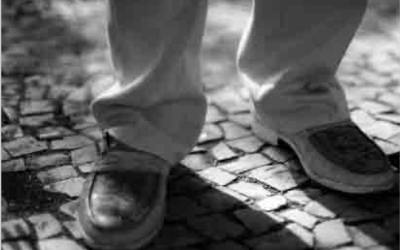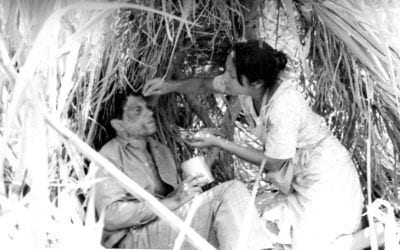Long Live My All-Time Favorite Latin American Film!
I’m rarely given to superlatives, especially those of the “all-time favorite” variety. My favorite color? Depends on the weather. My favorite ice cream flavor? Depends on what I had for lunch. My favorite Latin American movie? Depends on what happens to be consuming my every thought, my every intellectual exercise at the moment. If that moment were now (and it is, and may be for weeks, months, possibly years to come), said favorite film would no doubt be Glauber Rocha’s A Idade da Terra (The Age of the Earth). Completed in 1980 after nearly a decade of tortured gestation and shortly before the director’s death, The Age of the Earthbelongs among the most important works of cinema of all time, despite (or perhaps because of) its virtual anonymity among cinephiles and film scholars the world over. But then I’ve just managed to contradict myself twice already, having bequeathed two superlatives to a single film in the space of a single paragraph. Surely, this must be yet another effect of the film’s greatness.
Indeed, I might also venture to call The Age of the Earth the most important work of Glauber’s entire oeuvre, though I would in no way consider it his best film, if by “best” we mean aesthetically or commercially successful, or for that matter conceptually coherent in any way. Rather, what distinguishes Glauber’s magnum opus is precisely all that it refuses to contain, the subterranean forces it unleashes moment upon burgeoning moment, in convulsions of visual and sonic excess. Shot in cinemascope and rich, saturated colors, arrayed across sixteen reels of celluloid that, according to the Brazilian director’s own indications, were devoid of any order, the action of The Age of the Earth oscillates between the cities of Brasília, Rio de Janeiro, and Salvador though, truth be told, one cannot properly speak of “action” inThe Age of the Earth, at least not in any conventional dramatic sense. To oversimplify with no small measure of violence, Glauber’s final work recasts the Biblical Four Horsemen of the Apocalypse in the key of the Third World, and develops the peregrinations of each in ever accumulating conceptual dimensions from one episode to the next.
Over the course of the film’s 150-odd minutes, Glauber’s four Christs—or Kryztos, to adopt the director’s idiosyncratic orthography—also wage intermittent war against, and frequently collude with, one John Brahms (Maurício do Valle), an imposing, blond-haired, blue-eyed, pot-bellied schizophrenic who embodies, at once, the Gringo capitalist, the Father of Christ, Lucifer in a leisure suit, and the ecstatic European tourist on his first foray into the tropics, though without nearly enough sunscreen. Neither the black, messianic, evangelizing Kryzto (Antônio Pitanga), nor the saturnine Iberian Kryzto-Conquistador (Tarcísio Meira), nor certainly the fragile, indecisive, Oedipalized Kryzto-warrior (Geraldo Del Rey), nor even the native Brazilian Kryzto of “the people” (played, mind you, by the unambiguously Caucasian Jece Valadão) will manage to avert John Brahms’s disaster, though neither will Brahms ever truly succeed at bringing the Third World to reckon. Rather, all five figures, along with the women who serve as their foils (Norma Bengell’s New Age Eve; Danuza Leão’s corrupt Mary; Ana Maria Magalhães enigmatic Cleopatra) will meld the stentorian refrains of their voices, the labored intensity of their gestures, and the opaque mass of their bodies with a subtly disembodied lighting scheme and the unpredictable, alternating stasis and disquietude of the camera, its wide lens unwilling to bind itself to the canons of landscape, together forming a kind of suppurating two and a half-hour wound of cinematic extravagance. At last, Glauber’s penchant for teleology and totalizing national allegory are no match for the pure revolutionary force of the transe—the state of trance—he so often indicted in his earlier films. In The Age of the Earth, what remains or, more precisely, what emerges is an immanent, unresolved, uncontainable impurity. More important, Glauber’s last film is less a cinematic object than a work of pure film philosophy, an example of what French philosopher Gilles Deleuze termed a schizoid “image of thought.” That is to say, it is no longer Glauber thinking—however brilliantly—through the medium of his film, as had been the case with his earlier masterpieces, Black God, White Devil(1963) and Land in Anguish (1967). Instead, The Age of the Earth thinks for itself in the most protean of registers, despite Glauber, and despite whatever pretensions to meaning he may have had. And it is precisely for this reason, that is, for the film’s capacity to go on thinking long after the experience of its making, long after the death of its author, that qualifies The Age of the Earth as among the most important films of all times, Latin American or otherwise.
Fall 2009, Volume VIII, Number 3
Greg Cohen is Andrew W. Mellon Postdoctoral Fellow in the Humanities and Lecturer in Cinema and Media Studies, Department of Film and Television, University of California, Los Angeles. He received his Ph.D. in Romance Languages and Literatures from Harvard University in June 2008. He is currently at work on his first book manuscript, provisionally titled Latin American Cinema and the Spatial Unconscious.
Related Articles
Film in Latin America: Editor’s Letter
For me, movies are magic. And movie going is an emotional experience or maybe I should say, two types of emotional experience. I love to go to a film by myself, curl up in the seat and lose myself in the darkness to the big screen. I also delight in going with friends, passing the…
García Márquez and Cinema
English + Español
Gabriel García Márquez’s passion for film has always been constant and multifaceted. He has written film reviews; he has produced an extensive report about filmmaker Miguel Littin, Clandestine in Chile; he has led script workshops/La pasión de Gabriel García Márquez por el cine ha sido constante y ha tenido múltiples facetas. Ha escrito crónicas de cine; ha escrito guiones que se han llevado a la pantalla y otros que sólo han visto la luz a través de las palabras; ha escrito un extenso reportaje sobre el cineasta Miguel Littin Clandestino en Chile
With Santiago Álvarez, Chronicler of the Third World
English + Español
Santiago Álvarez (1919-1998) brought together the founding group of the Instituto Cubano del Arte e Industria Cinematográficos (ICAIC) in 1959/Santiago Álvarez (1919-1998) integró el grupo fundador del Instituto Cubano del Arte e Industria Cinematográficos (ICAIC) en 1959.




